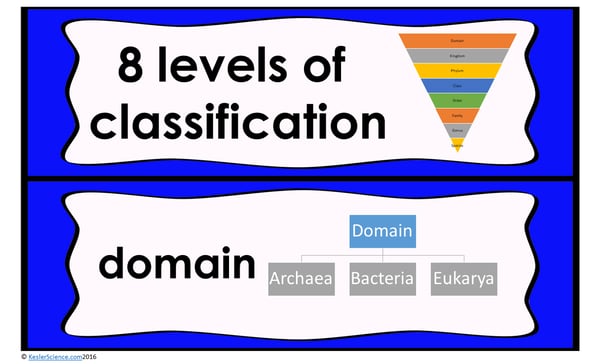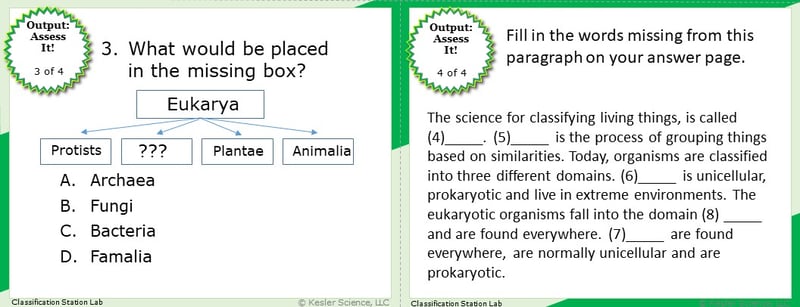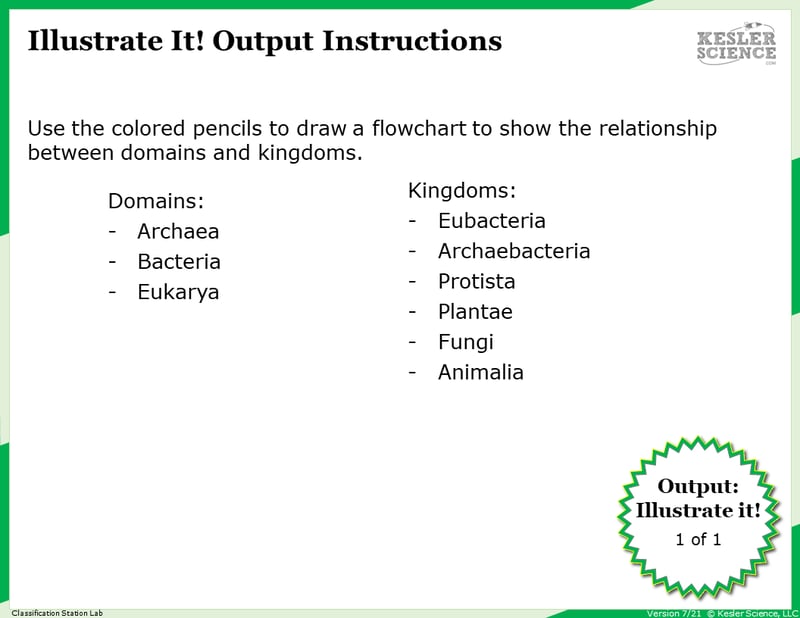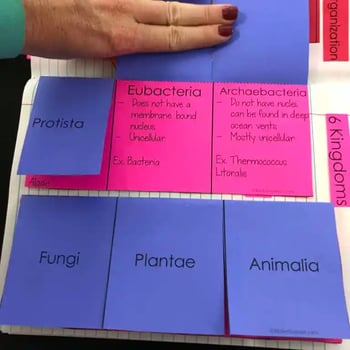Classification Lesson Plan – A Complete Science Lesson Using the 5e Method of Instruction.
By the end of this comprehensive lesson about Linnaean taxonomy, students will be able to recognize how the broadest taxonomic classifications of living organisms are divided into their currently recognized Domains. Each of our lessons is designed using the 5E method of instruction to ensure maximum comprehension by the students. This well-thought out unit does the heavy lifting, giving teachers easy-to-implement, highly engaging lesson plans.
The blog below will walk you through each of the steps and activities from the Classification 5E Lesson Plan.
ENGAGEMENT
At the beginning of the lesson, the class will do a Think-Pair-Share to discuss the objective. Students will then be asked to get into groups of three to four for a classification activity. The teacher will pass out bags of either a mixture of plastic animals or Legos and students will have to come up with a classification system to organize their materials.


The teacher will then help to clear up any misconceptions their students have about classification. Common but major misconceptions, for example, include how classification is putting things into groups based on how different they are, or students think that minerals can also be placed into Kingdoms.
Estimated Class Time for the Engagement: 20-30 minutes
EXPLORATION
With nine stations in total, you can introduce classification to your middle school students in a variety of ways! Four of these stations are considered input stations where students will learn new information about classification, and four of the stations are output stations where students will be demonstrating their mastery of the lesson's material. A bonus station offers challenges for your early finishers and independent learners. You can read more about how I set up the station labs here.
Watch It!
At this station, students will be watching an almost three minute long video describing classification and what organisms are located in each Domain. Students will then answer some questions relating to the video and record their answers on their lab station sheet. For example, students will have to explain how Bacteria and Archaea are different from Eukarya, describe the types of organisms that are classified into the Archaea Domain, and list three characteristics of eukaryotic organisms.
Read It!
This station will provide students with a one-page reading about the classification of living things. In the reading, students will discover how life is covered all over this planet. 3.7 billions years of history and evolution has helped to create many different living things, which until recently, has been divided up into two categories – plant or animal. Students will learn about why scientists created sub groups and why grouping organisms by their like characteristics prove to be a better method than ones of differences. There are four follow-up questions that the students will answer to demonstrate their comprehension of the reading material.
Explore It!
Students will be working in pairs to classify buttons into three categories and explain what characteristic lead them to create those three categories. Students will then take those three categories and create two sub categories within each of the original categories they made. Students will be challenged a final time to see if their categories can be divided into even smaller ones.
Research It!
The research station will allow students to get online and participate with an interactive website. On the lab sheet, students will have to list three organisms they classified and explain what characteristic lead them as to why they put them into a certain kingdom.
Organize It!
The Organize It station allows your students to match the characteristics of each Domain. Archaea, Bacteria, and Eukarya will have a number of cards containing characteristics that students will have to read and place under the correct Domain.
Illustrate It!
Your visual students will love this station. Students will be creating a flow chart of the three Domains and the Kingdoms that fall under each of the Domains. Students will use different colored pencils to represent different categories.

Write It!
Students who can answer open-ended questions about the lab truly understand the concepts that are being taught. At this station, the students will be answering three questions like explain why scientists use a classification system, how prokaryotes are different than eukaryotes, and to describe the three main domains used to classify living things.
Assess It!
The Assess It station is where students will go to prove mastery over the concepts they learned in the lab. The questions are setup in a standardized format with multiple choice answers. Some questions will ask students: identify the names of each of the three Domains, which Domain can animals be found, identify the missing Kingdom and identify a characteristic.

Challenge It! - Bonus Station
Early finishers and advanced students will love the extension activities in this station. Four activity choices offer them ways to expand their learning through mini-games and mini-projects.
Estimated Class Time for the Exploration: One or two 45-minute class periods
EXPLANATION
The explanation activities will become much more engaging for your class once they've completed the exploration station lab. During the explanation piece of the lesson, the teacher will be clearing up any misconceptions their students may have about modern classification with a variety of materials. These materials include on-level and modified versions of the interactive presentation (may be used individually or projected), anchor charts, and paper or digital interactive notebook activities. If you have students that need modified notes, the 5E lessons come equipped to help give every student access to the lesson.

Interactive notebook samples: Above-left is a digital INB activity slide; above-right is an example of the paper INB activities.
The students will also be interacting with their journals using INB templates for classification. Each INB activity is designed to help students compartmentalize information for a greater understanding of the concept. The classification INB template will describe the different characteristics and organisms that make up each Domain and Kingdom.
Estimated Class Time for the Exploration: Two or three 45 minute class periods
ELABORATION
The elaboration section of the 5E method of instruction gives students choices that allow them to prove they’ve mastered the concepts behind the lesson. When students are given a choice, they’re much more enthusiastic and invested in the project than they are when their teachers choose their projects for them. There are a total of nine choices to demonstrate understanding of modern classification. A separate set of choices that offer more teacher support are also available for students that need them. Rubrics guide students to doing their best work and assist in grading.

Estimated Class Time for the Elaboration: Two or three 45-minute class periods (can also be used as an at-home project)
EVALUATION
The final piece of the 5E model is to evaluate the students' comprehension. Included in every 5E lesson is a homework assignment, assessment, and modified assessment. Research has shown that homework needs to be meaningful and applicable to real-world activities in order to be effective. When possible, I like to give open-ended assessments to truly gauge the student’s comprehension.
Estimated Class Time for the Elaboration: One 45-minute class period
DOWNLOAD THE FULL LESSON NOW
Download Over $100 in FREE Resources
For Middle School Science
Simply create a login below and gain immediate access to a selection of our Kesler Science product line worth $100 - for FREE. There's a full version of every product type! You'll also join tens of thousands of middle school science teachers who receive timely tips and strategies straight to their inbox.







